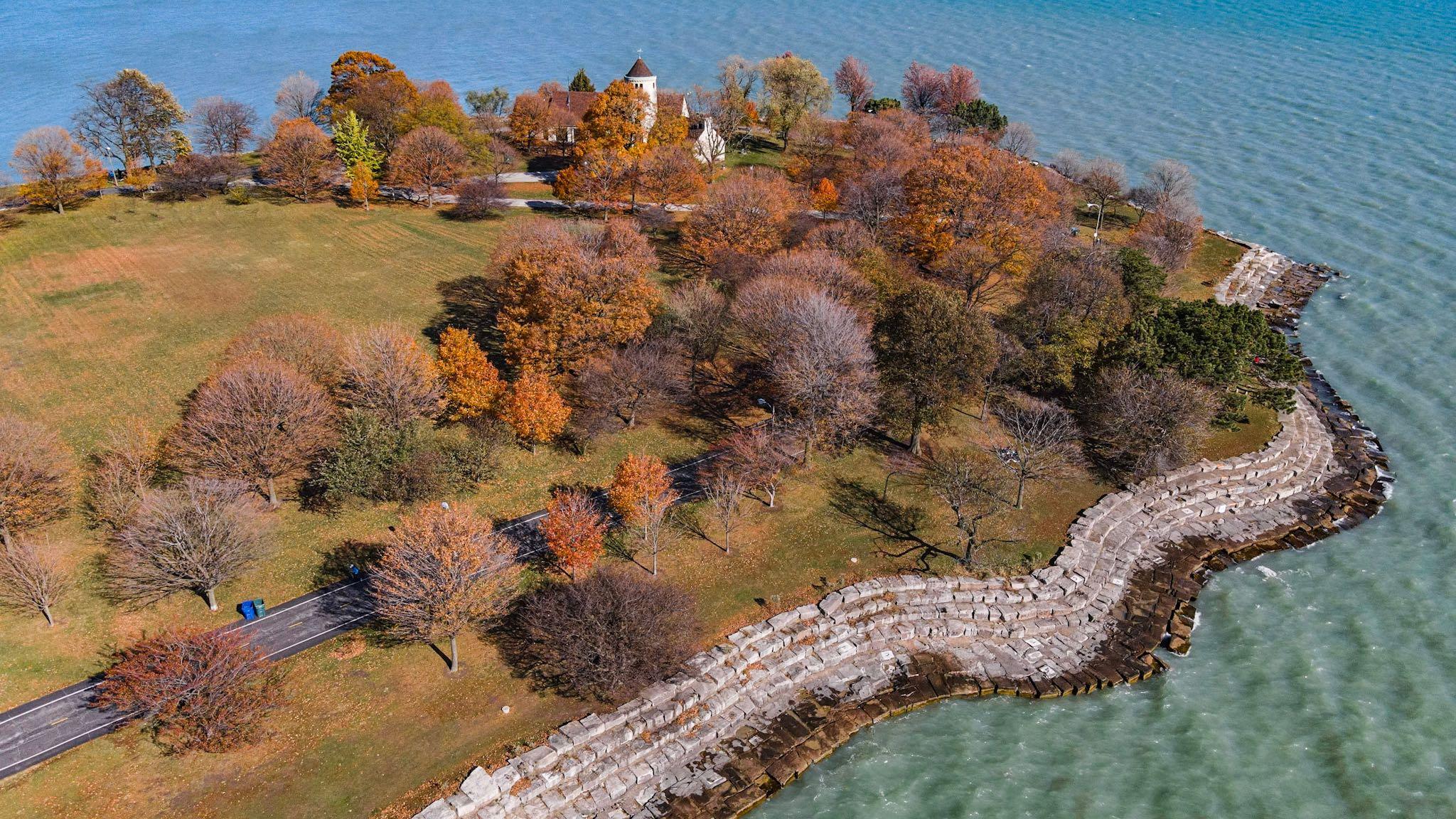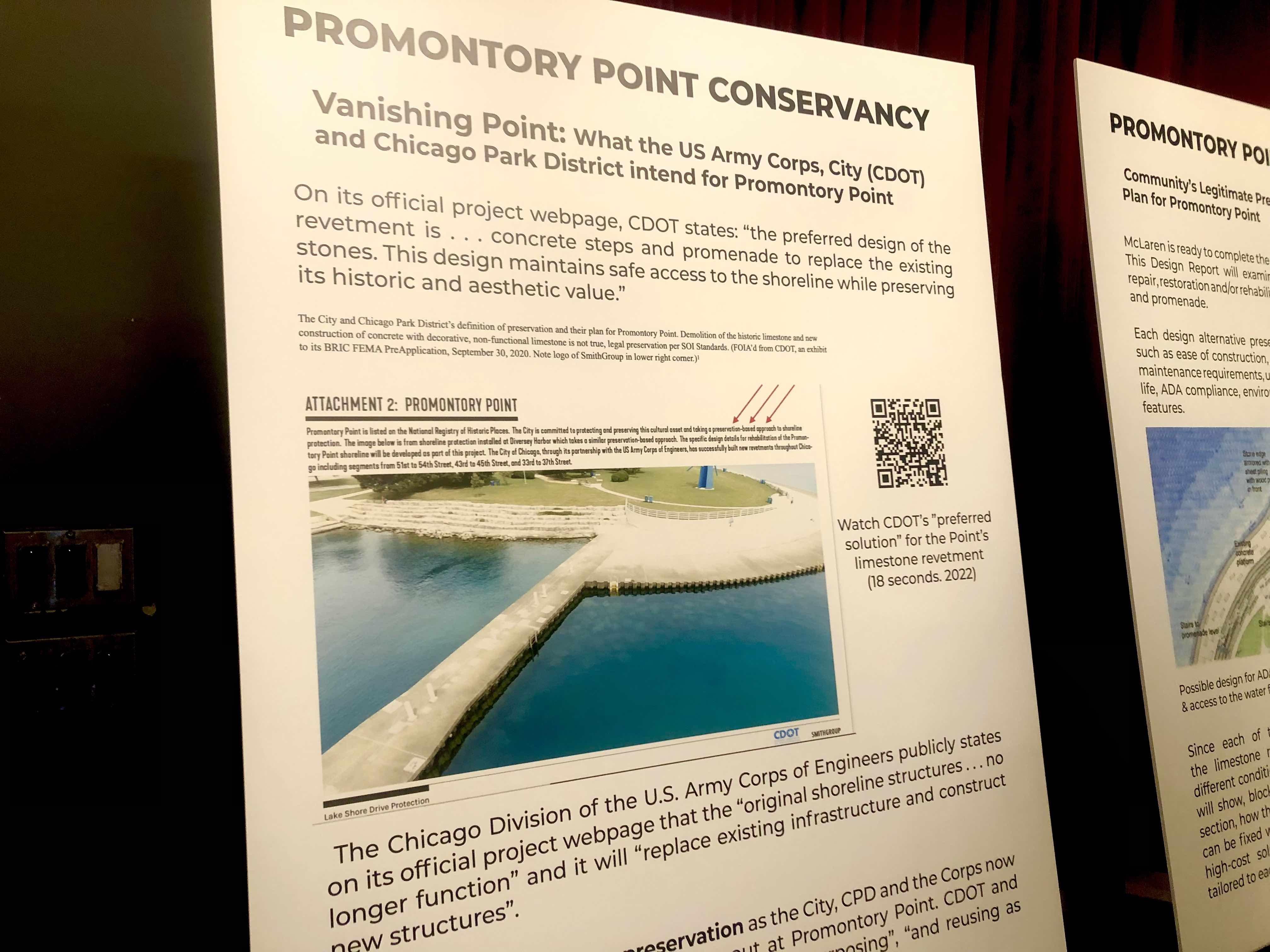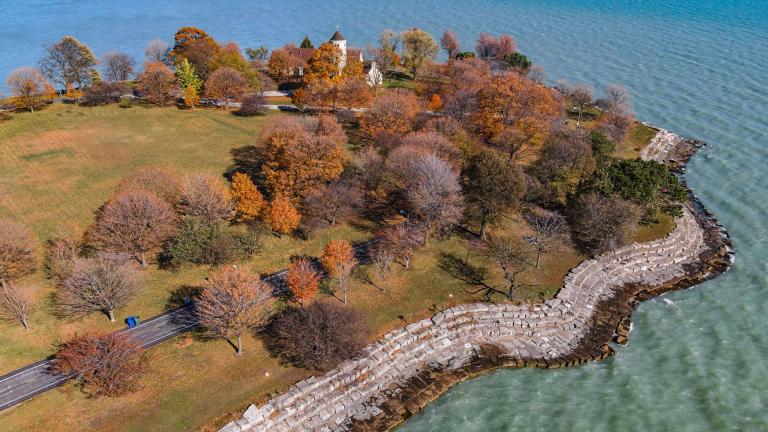 Promontory Point. (Eric Allix Rogers / Preservation Chicago)
Promontory Point. (Eric Allix Rogers / Preservation Chicago)
For years, members of the Promontory Park Conservancy have been locked in a battle with the U.S. Army Corps of Engineers over the fate of the Point’s historic limestone stair-step revetment on Lake Michigan.
The Corps has claimed the existing structures no longer protect against storms, flooding and erosion, and need to be replaced, much like the Corps has done elsewhere along the shoreline, pulling out limestone and swapping in a concrete bulwark.
The conservancy — a community nonprofit originally formed as Save the Point — has countered that the limestone works just fine and is simply in need of repair.
Now the conservancy says it has the proof to back up its argument.
On Thursday, the Promontory Park Conservancy released the results of an independent condition study it commissioned from McLaren Engineering Group. McLaren had its engineer-divers inspect the Point from above and below and concluded that the limestone blocks currently in place along the Point’s shoreline are structurally sound, function as intended, aren’t in danger of collapse and provide critical shoreline protection for the inland park and south lakefront.
“It is McLaren’s professional assessment that ... with maintenance and repairs, the service life of the structure can be significantly extended, obviating the need for major demolition and replacement,” the study said.
Among McLaren’s key findings:
— The vast majority of limestone blocks at the Point are generally in good condition. Less than 25% would need to be replaced.
— Shifting and displacement of the current limestone blocks is almost entirely due to the loss and erosion of replaceable underlying (“subgrade”) earth and material. Repairing and restoring this layer — and providing for continual maintenance — would halt deterioration.
— Furthermore, much of this “deterioration” is purely aesthetic and not necessarily deleterious to the protective structure or function of the Point, according to the report.
That assessment directly contradicts a condition study the Chicago Park District commissioned, which suggests sections of the Promontory Point revetment have “failed.”
Promontory Park Conservancy has requested access to that study on multiple occasions and never obtained a copy, except for one that was so redacted with black ink that it looked like something from Guantanamo Bay, said Jack Spicer, founder and president of the conservancy.
Unlike the Park District, the conservancy will gladly share its study, which, though funded by the conservancy, Spicer said, is professional, thorough, scientific and objective.
“We hired them to tell the truth,” said Debra Hammond, the conservancy’s treasurer.
 Community members have been fighting for decades to preserve Promontory Point’s limestone steps. (Patty Wetli / WTTW News)
Community members have been fighting for decades to preserve Promontory Point’s limestone steps. (Patty Wetli / WTTW News)
At a news conference held Thursday morning, elected officials and preservationists alike — many of whom have a deep connection to the Point — called on the city and Army Corps to go on the record and commit to a shoreline protection plan that retains the historic limestone.
Neither the Park District nor the Army Corps immediately responded to a request for comment from WTTW News. But the Chicago Department of Transportation did send a statement to Ald. Desmon Yancy (5th Ward) in advance of the news conference; he read the statement aloud to the gathered crowd of community members.
That statement from CDOT said, in part: “There is no intention of replacing the limestone with a continuous concrete revetment. … We look forward to working closely with the community, elected officials and other stakeholders on the developing a rehabilitation plan that preserves the limestone and historic character of this beloved segment of shoreline for future generations.”
“So they said it. They said it,” Yancy said, to cheers and applause from the audience. “I’m really glad that we’re hearing this. However, ... let’s make sure this process is transparent because there are reports that have been done over the last couple of years that say otherwise, other than what is in this statement today.”
CDOT responded further to WTTW News: “The Chicago Department of Transportation and the Chicago Park District, as partners alongside the U.S. Army Corps of Engineers in the implementation of the Chicago Shoreline Project, are committed to saving and reusing as much of the existing limestone as possible. … The project approach to Promontory Point has evolved significantly since what was contemplated 20 years ago. The project partners are fully committed to preserving the Point’s historic nature while protecting it against erosion.”
Video: Ald. Desmon Yancy (5th Ward) reads a statement from CDOT on plans for Promontory Point during a news conference on April 4, 2024. (Patty Wetli / WTTW News)
Promontory Point, a manmade peninsula that juts out into Lake Michigan off of DuSable Lake Shore Drive between 54th and 56th streets, was built between 1922 and 1939.
During that period, the Works Progress Administration constructed 9.2 miles of limestone steps along Chicago’s shoreline, with Promontory Point’s 3,150-foot section the only surviving remnant of that effort.
“This stepped limestone is a unique solution to the problem of erosion and forms the transitional link between the natural power of Lake Michigan and the built environment of the city,” said Kendra Parzen, advocacy manager for Landmarks Illinois. “The loss of this final piece of revetment would complete the erasure of this resource, taking with it evidence of engineering history and the history of the city of Chicago.”
Aside from the historic value of the revetment, the stones have formed the foundation of a community that’s gathered at the Point for decades, Hammond said, and that’s what the conservancy is striving to maintain, as much as the limestone itself.
People come to the rocks to meditate and pray, dip their toes into the lake or nestle their back into a warm stone on a cold winter day.
“The rocks are beautiful,” Hammond said. “They’re made for people.”
Speakers at Thursday’s news conference — state Sen. Robert Peters (13th District); Cook County Commissioner Bill Lowry; and Gin Kilgore, interim executive director of Friends of the Parks — all shared memories of the Point, from family walks as youngsters to teenage antics best left unsaid to cookouts hosted as newly married adults.
“I grew up taking walks with my dad, entranced by the giant ‘blocks,’ because I did not have those fancy words like ‘limestone’ and ‘revetment,’” Kilgore said. “They were just big blocks like the ones I played with at home. The rough and tumbled spots conveyed strength and security for persisting against the lake’s angry moods.”
The concrete embankments seen elsewhere on the shoreline don’t have the same natural charm — “It’s very brutal looking, like a wall to hold off an armed invasion from Wisconsin,” Spicer said — and they don’t allow people to get as close to the water. But they do encourage cyclists, scooters and other wheeled contraptions zooming along the smooth pavement, uses at odds with the Point’s mellower vibe.
“We’d lose the sunbathers and pray-ers and meditators,” Hammond said.
Which doesn’t mean the conservancy is against making the Point easier for people to access, be it individuals with disabilities or folks less sturdy on their feet (a group that could include anyone from toddlers to senior citizens).
“Clever designers will come up with good ideas,” Spicer said. Options including building a ramp or — something Spicer witnessed firsthand at Lincoln Park’s Lily Pool — swapping out a portion of a limestone path for gravel.
“They came up with a beautiful compromise,” he said. “We’re not hard-a**es. We’re going to compromise for accessibility.”
 A photo shared by Promontory Point Conservancy as CDOT’s plan for the Point is actually an image of Diversey Harbor, CDOT told WTTW News. “The concrete in the photo is not relevant to what is currently being considered for Promontory Point, as it is not the intent of the City to construct a concrete revetment at the Point,” said a CDOT spokesperson. (Patty Wetli / WTTW News)
A photo shared by Promontory Point Conservancy as CDOT’s plan for the Point is actually an image of Diversey Harbor, CDOT told WTTW News. “The concrete in the photo is not relevant to what is currently being considered for Promontory Point, as it is not the intent of the City to construct a concrete revetment at the Point,” said a CDOT spokesperson. (Patty Wetli / WTTW News)
As the McLaren study notes, just because limestone revetments aren’t typically used as solutions today doesn’t mean they’re ineffective, outdated or derelict.
“Structures like the Point are not common today ... because few municipalities have the initiative and funding to build structures from this sort of material,” McLaren said. “The current condition of this structure and the condition of the upland park are testaments to the quality of design, the workmanship, and the use of resilient materials.”
Indeed, McLaren continued, the resiliency of those materials, particularly in the context of climate change, should place even greater priority on retaining rather than replacing the limestone.
“It is worth noting that concrete production is the world’s third highest producer of man-made carbon dioxide and, once employed in the built environment, (concrete) significantly intensifies the urban heat island effect,” the study said. “The limestone currently in use, conversely, meets the environmental justice criteria of sustainability, durability and cost-effectiveness.”
“There are lots of reasons for reusing limestone,” Hammond said, not the least of which is sustainability, but it would also give Chicago something to brag about.
“This could be a world-class solution for a world-class city,” she said.
Landmark Loophole
Save the Point beat back a plan more than 20 years ago to remove the Point’s iconic limestone, but concerns the rocks might once again be at risk surfaced in the wake of record high lake levels and subsequent erosion of Chicago’s shoreline in 2020 and 2021.
The Army Corps received funding in early 2022 to undertake a fresh study of the lakefront’s protections, setting preservationists on high alert.
Federal legislation passed at the end of 2022 mandates that a “locally preferred plan” for shoreline protection take precedence over the Army Corps’. While “locally preferred” encompasses groups like Promontory Point Conservancy and Preservation Chicago, it also includes input from the city of Chicago and the Chicago Park District.
In 2023, supporters of the Point pushed for and received Chicago landmark status, not just for the revetment but the upland park, too. Many assumed the war had been won, with a landmark seal providing rock-solid protection.
Not so, said Spicer.
The landmark ordinance allows for the demolition of a landmark if it’s been deemed unsafe or structurally failing, and that’s a loophole “big enough to drive concrete trucks through,” Spicer said.
With a study in hand that plainly states “the limestone blocks have not failed,” Promontory Point Conservancy has an appraisal that counters the prevailing official narrative. The group “would like to engage the Park District and city ... as soon as they’re willing to sit down,” Spicer said.
The conservancy should also have an alternative design completed by June — including some of the aforementioned accessibility options — which it plans to share with the community at a series of public meetings.
“We have a legitimate study that will save public funds, that will protect the shoreline, that will maintain access and that will protect a treasured Chicago landmark,” Kilgore said. “It is time to stop having to protect the Point from misguided plans and starting the work of preserving it.”
Note: This article has been updated following an April 4, 2024, news conference.
Contact Patty Wetli: @pattywetli | (773) 509-5623 | [email protected]





